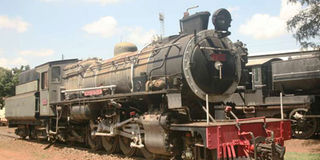A trip back in time at the Railway Museum

The 1923 locomotive at the Railways depot. If you are a railway buff you could get extremely excited about the old steam and diesel locomotives on display on the tracks outside, and about all the paraphernalia inside the museum. PHOTO | JOHN FOX
What you need to know:
- There’s a copy of a poster in the museum from the early 1920s that says a lot in a few words about the origins of the colony. It features the railway (then called the Uganda Railway), reaching to the Nairobi Station, after passing through a land peopled with animals.
- One of the fun things is a bicycle, fitted as a trolley to the rails, which used to be ridden by the Nairobi-based “permanent way” inspectors. Another fun seat is the one at the very front of the engine — with a photograph of it being enjoyed by the Prince of Wales when he visited Kenya in 1928.
- Much less funny, but no less intriguing, are the chairs and table — a collection of furniture, in fact — from the captain’s cabin of SMS Konisberg, sunk in the Rufiji Delta by British warships in 1914.
The clouds were threatening early last Sunday morning. Not a day for a park walk or a garden brunch. It was a day for doing something indoors.
So I decided to accept the management’s invitation to re-visit the Railway Museum. They told me that I would find new things to see.
It is one of Nairobi’s gems — I would rate it somewhat higher than TripAdvisor’s rating of 23 out of 91 things to do in Nairobi. If you are a railway buff you could get extremely excited about the old steam and diesel locomotives on display on the tracks outside, and about all the paraphernalia inside the museum — the old photographs, maps, charts, models, and bits and pieces that made up the equipment for a fascinating railway adventure.
Even if you are not such a buff, you are bound to learn a lot, in an entertaining way, about how the railway has had such a tremendous influence on the development of modern Kenya.
It was back in 1903 that Sir Charles Eliot — no, let me give you his name in full — Sir Charles Norton Edgecumbe Eliot, the Commissioner and Consul General for the British East Africa Protectorate, said: “It is not uncommon for a country to create a railway, but it is uncommon for a railway to create a country”.
Well, it would perhaps be more accurate to say that the railway created not a country but a colony. Because, once the British Government had agreed to build the railway (what one disagreeing British politician called the “lunatic line” and a “gigantic folly”) it went out of its way to encourage settlers in order to make the railway pay.
And so, in 1920, the East African Protectorate became the Kenya Crown Colony.
WINTER HOME
If you are into history and want a very lively account of the origins and growth of pre-Independence Kenya then, I say again, get hold of a copy of Charles Millar’s The Lunatic Express. It reads like a well-written novel.
The small brochure produced by the Railway Museum, A National Heritage, makes for a good read, too — racy, though not always accurate. It says that the story of the railway is one of “mystery, intrigue, death, and some romance thrown in just to thicken the plot”. That’s true enough!
There’s a copy of a poster in the museum from the early 1920s that says a lot in a few words about the origins of the colony. It features the railway (then called the Uganda Railway), reaching to the Nairobi Station, after passing through a land peopled with animals. And the words are: “The Highlands of British East Africa as a Winter Home for Aristocrats has become a Fashion.”
There are so many intriguing things in the museum. Let me select a few. There is the compass binnacle from the “William Mackinnon”, for instance, the first steamer on Lake Victoria, having been brought from Britain to Mombasa in pieces and carried on the heads of porters all the way to the lake.
One of the fun things is a bicycle, fitted as a trolley to the rails, which used to be ridden by the Nairobi-based “permanent way” inspectors. Another fun seat is the one at the very front of the engine — with a photograph of it being enjoyed by the Prince of Wales when he visited Kenya in 1928. Much less funny, but no less intriguing, are the chairs and table — a collection of furniture, in fact — from the captain’s cabin of SMS Konisberg, sunk in the Rufiji Delta by British warships in 1914.
Outside (and I was able to walk round, because the rain didn’t fall), there is a wonderful collection of pensioned-off engines and carriages. Pride of place (forgive the pun) perhaps goes to the 1st Class coach from which the Superintendent of Police, Charles Ryall, was dragged and killed by a lion at Kima station, some 80km from Nairobi, in June 1900.
True, there were a few different items on display from when I was last at the museum some years ago. Also, there is now an Arts Studio in one of the old railway sheds. I chatted with the founding artist, young Peter Ndirangu, who paints with strong colours in a Cubist style.
For sales, this group of seven young artists depends on visitors to the Railway Museum. They told me they were finding times tough. Last Sunday morning there was just one mzungu family there. The place deserves better patronage. A small teashop might be a good idea.
And how to get there? It’s along the Nairobi Railway Station in the direction of Uhuru Highway. But, by car, you have to take the Workshop Road off Haile Selassie Avenue.





